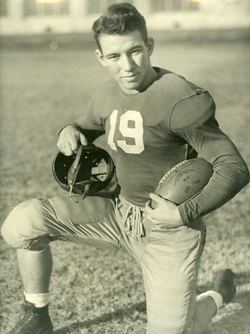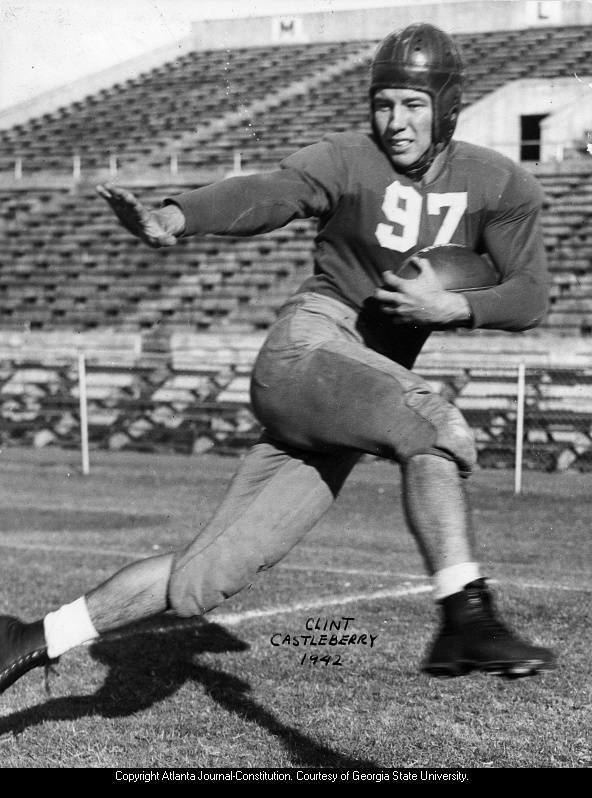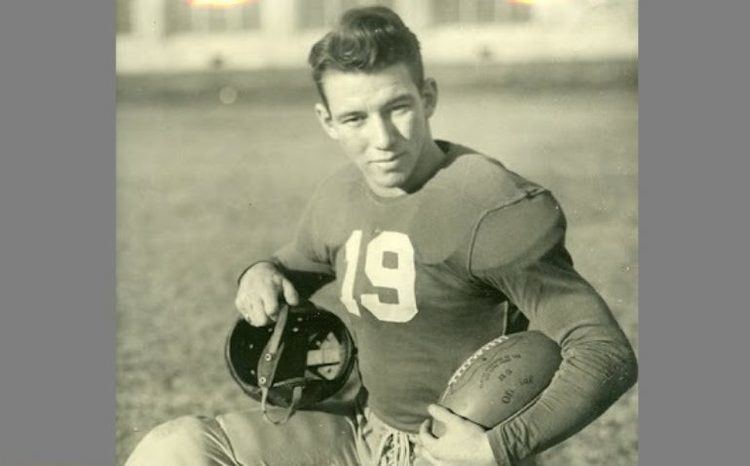Date of birth October 10, 1923 Height 1.75 m Name Clint Castleberry Weight 70 kg | Date of death November 7, 1944 Role Football player Career end 1942 | |
 | ||
Awards 1942 All-SEC2nd Team All-America3rd Place Heisman Education Georgia Institute of Technology | ||
Clint castleberry georgia tech
Lt. Clinton Dillard Castleberry, Jr. (October 10, 1923 in Atlanta, Georgia – November 7, 1944) was a football player in the 1940s. Georgia Tech coach Bobby Dodd said that if Castleberry had lived to finish his playing career “he’d have probably been an All-American for three years and been the greatest back in Georgia Tech history.”
Contents
- Clint castleberry georgia tech
- tbt clint castleberry leads georgia tech to win at notre dame 1942
- College football
- Army Air Forces
- References

tbt clint castleberry leads georgia tech to win at notre dame 1942
College football

Castleberry showed extraordinary ability as a Georgia Tech "pony" back, standing at only 5'9" and weighing only 155 lbs. In high school, he played for Boys High in Atlanta, where he averaged 171 rushing yards per game and scored 102 points. In 1942, freshmen were ruled eligible to play varsity ball as rosters were drained by World War II. This allowed Castleberry to display his spectacular prowess on the football field. On October 3, 1942, Georgia Tech beat Notre Dame for the first time since 1928, especially impressive as the game was played in South Bend and Notre Dame had not lost a game in two years. Castleberry led Georgia Tech in both passing and rushing yards, even after Notre Dame Head Coach Frank Leahy had been warned by a scout that Castleberry was "the most dangerous runner in America."

Against national power Navy, Castleberry led Tech to an impressive win on October 24, 1942 in Annapolis that was broadcast worldwide via the Armed Forces Radio Network. The momentum changer of the game occurred when Navy was driving for a score near the Tech goal line. Castleberry was put in to play defense on a passing situation on fourth down. He anticipated the Navy pass and stepped in front of the intended receiver for an interception. He scampered away with a dazzling run of 95 yards for a touchdown. Tech coach Bobby Dodd described it as “a magnificent run that I can still follow step by step in my mind. It shook Navy to its keel, and Tech won 21-0.” Dodd called it Castleberry’s greatest play. The national press began to take notice of Castleberry.
Georgia Tech started the season 9-0 and climbed to a top five national ranking. During that ninth win, Castleberry injured his knee in a hard-fought 20-7 win over Florida in Atlanta. Despite the injury, Castleberry played in the final two games of the season, but not quite at full speed. On New Year's Day, Tech traveled to the Cotton Bowl Classic, losing a tight game with Texas, 14-7. Castleberry's injury improved for the bowl game, yet he was still not quite a hundred percent.
Castleberry finished third in the Heisman trophy voting for the season, behind winner Frank Sinkwich and Paul Governali, both seniors. This was the highest a freshman had ever placed in the Heisman voting. Castleberry's number 19 is the only football jersey Georgia Tech has ever retired.
Army Air Forces
After the 1942 season was over, Castleberry enlisted in Army Air Forces and planned to return to play football at Georgia Tech after the War. Castleberry underwent surgery on February 2, 1943 at the Crawford Long Hospital in Atlanta to repair his damaged knee. He withdrew from Georgia Tech on February 18 and reported for military duty in Miami. After a physical evaluation by Army doctors, it was determined that Castleberry was fit for service.
Castleberry completed Army flight school training and earned his wings in the summer of 1944. He was sent to the Mediterranean Theatre in the fall. He co-piloted a B-26 Marauder bomber known as "Dream Girl" and was stationed in Africa. In the early morning hours of November 7, 1944, Lt. Castleberry took off from Roberts Field in Liberia with another B-26 to continue a ferrying run up the coast toward Dakar, Senegal. Neither of the two planes made it to their destination. An extensive six-day search involving American and British search crews was conducted. On November 23, 1944, all crew members were officially re-classified from MIA to KNB (killed, no body) after a British RAF plane observed unidentified wreckage believed to have been from the missing planes.
